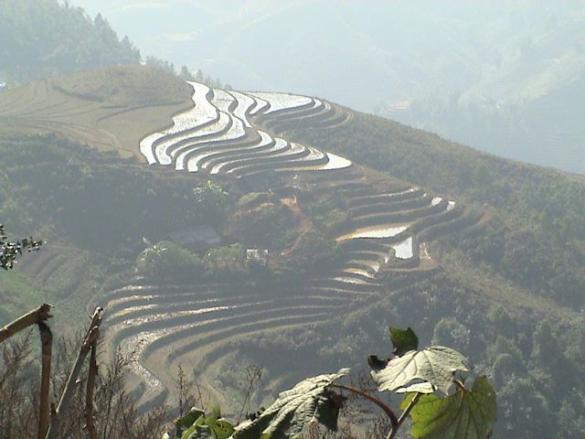
 Sapa
Sapa
The night is cool and crisp and we are boarding our train from Hanoi,
Vietnam to the northern mountain town of Sapa. Our train is a modern
overnight sleeper; clean, comfortable, and sparkling white. The rest of
the station is like stepping back in time. Ancient boxcars darkened by
time, are parked in the yard, and steam is rising in the air. People
donning conical hats are huddled around open fires. Some squat on small
plastic stools eating noodle soup with chopsticks. As I look out the
window I feel as though it is 1969.
We are led to our bunks by a petite and quiet women from ODC Travel.
The company based in Hanoi where we booked our four-day, three-night
excursion. For $75 each, all meals accommodation and transportation are
included in our trip to see the magnificent rice terraces and to
experience the traditional lives of the hill tribes of Sapa.
It is not long until I am peacefully sleeping. Rocking with the
rhythm of the train I dream of the adventure ahead. 4:30 am arrives
quickly however and I awake famished and thankful for the complimentary
sweet bread and bottled water.
We have arrived in Lao Cao, a small town on the Chinese border. As I
step onto the platform a brisk, cold wind awakens my senses. Luckily, a
van is waiting to take us the rest of the way, so we don’t have to wait
in the morning chill for long.
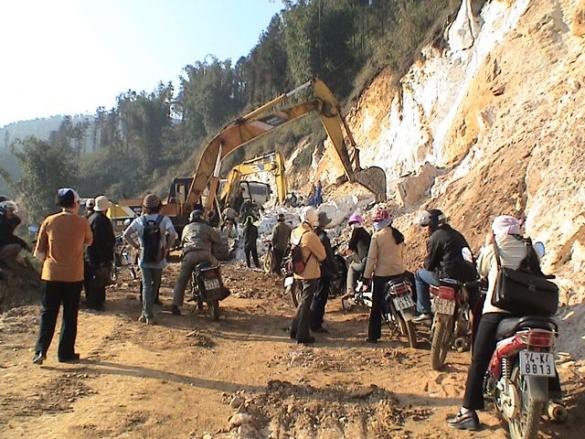
 Mountain Road
Mountain Road
It is a harrowing journey up the winding mountain road. We put our
lives in the hands of our speeding driver who dodges herds of water
buffalo, oncoming traffic and local villagers herding their oxen.
Whizzing around each corner, we are thankful to not have plunged off of
a vertical cliff into the deep valley below.
We arrive a little shaken but all in one piece to our hotel where we
meet our guide, Xin. He is a friendly young man who grew up in the area
and as we will soon learn, enjoys singing and playing the guitar. We
will be spending the next two days with him as he takes us through the
mountains to visit the Hmong and Dzai People who live among the rice
terraces.
The morning is beautiful. The sun in shining, the chill is gone and
the blue sky is full of fluffy white clouds. After some tea and a hot
breakfast we shed our layers and begin our journey into the hills.
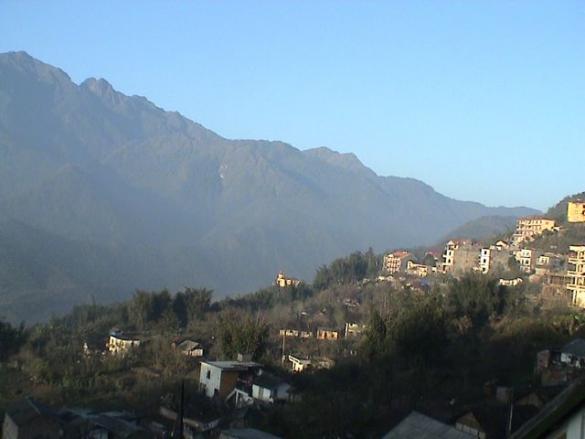
 Town of Sapa
Town of Sapa
The scenery is magnificent and as we venture farther from the town,
my breath is taken away by the incredible view unfolding. Thousands of
rice terraces filled with water glisten in the sun for as far as the
eye can see. Every turn becomes more overwhelming and I am struck with awe by the giant terraced mountains surrounding me.
Barking dogs guard their territory as we pass and gaggles of ducks
waddle by following their leader with frenzied dedication. Villagers
from the Hmong Tribe speed past us carrying heavy loads in their woven
baskets. They walk with ease as I gasp for air climbing the steep path.
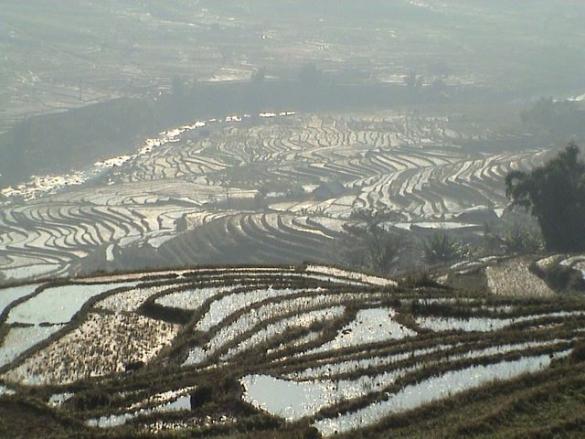
 Rice Terraces
Rice Terraces
As we continue to hike, Xin tell us about the people and the history
of the land and how it has changed. The Hmong village we are visiting
has come to depend on tourism and he tells us not to feel pressured to
give money or to buy jewelry to the people who will be approaching us.
Not wanting to contribute to a begging society, I chose not to give
children the "bonbons" that they have come to expect or to give money
for nothing. Instead, I gladly buy some silver bracelets from a lady
who invites us into her home for a glimpse of tribal life.
The house is stuffy and dark and a fire is burning in the kitchen.
We huddle around the flame as Xin points out that the Hmong people have
two fires in their dwellings, one for cooking the other for warmth.
Many generations live together under one roof and the house consists of
a large open room. It is a fascinating experience, but I feel a little
uneasy to be staring at these people who have put their lives on
display.
Leaving the Hmong Villages behind, we venture farther away from Sapa
and deeper into the mountains. I am relieved to not have people
pestering me for money and no more children asking me for candy.
We make our way to the top of a mountain, where Xin puts out a
picnic lunch and we dine among a herd of water buffalo. As we look into
the deep valley, children stop by for a visit and we share some cookies
and fruit. It is a place of overwhelming beauty.
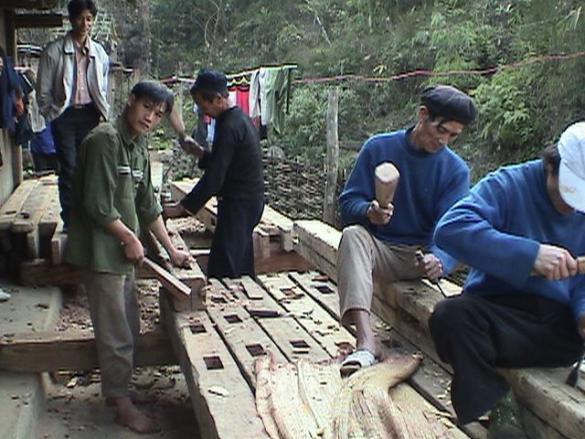
 Traditional Carpentry
Traditional Carpentry
The contentment is short lived however, because we have a lot of
ground to cover to make it to the village of the Dzai people where we
will be spending the night. Being farther away from Sapa and not a part
of the usual one-day tours, this tribe is less corrupted by the tourism
industry. They are completely self-sufficient at harnessing water from
mountain runoff for irrigation. They grow their own rice, sugar cane
peanuts and vegetables. Every child attends school, they raise their
own livestock, and weave and dye their own fabric for clothing. This is
truly a people who are at one with the land.
We stay with a family that has four generations living under one roof. Their house, built by the hands of villagers using traditional methods is gigantic and
surprisingly cozy in the brisk mountain air. It takes one year to build
a home and everybody pitches in.
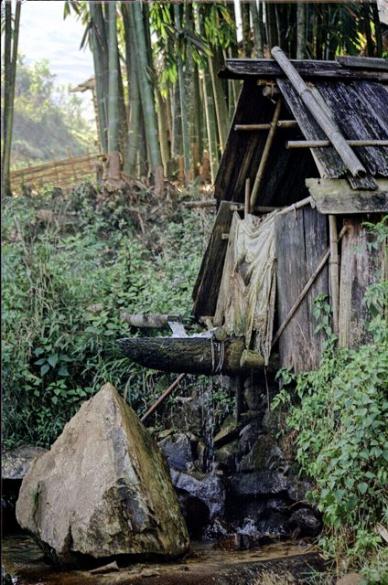
 Irrigation
Irrigation
We are treated to a feast after we settle in and enjoy their
friendly hospitality. The 94-year-old grandfather keeps my plate full,
urging me to eat more and we stuff ourselves until we cannot move.
After dinner, the rice wine is served and they will not take no for an
answer. So it is "bottoms up all night". Xin translates for us as we
tell them about our country and they tell us about their way of life.
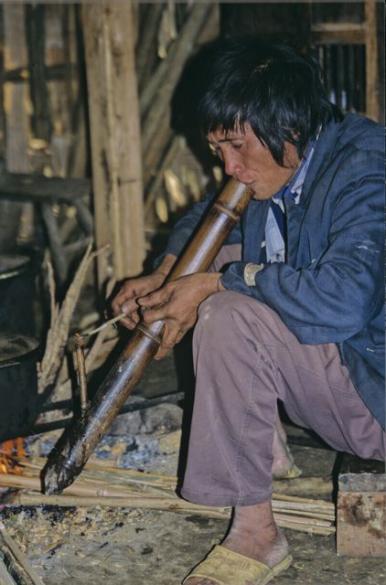

Later that evening we walk to visit other houses and the
celebrations continue. Rice wine is flowing as we sit around the fire
in their kitchens singing songs. The local people are eager to hear
songs from our country and there is no getting out of belting out a
tune. They applaud with enthusiasm and then Xin treats us to a
traditional Vietnamese folk song before heading back to bed.
It is a cool night, but we sleep well under a thick warm blanket and
awake a little groggy from the abundance of alcohol the night before.
Saying goodbye to our hosts after a breakfast of fried eggs and a
warm baguette, we slowly walk to the mountains feeling the burn in our
legs from the day before. We trek to the high waterfall overlooking the
valley, walk through a bamboo forest, and once again witness the beauty
of gigantic rice terraces.
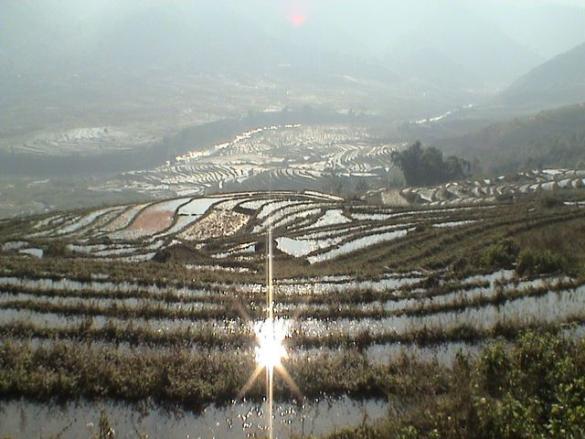
 More Rice Terraces
More Rice Terraces
A jeep picks us up at the end of our trek to take us back to Sapa
where we sleep comfortably that evening in our small hotel. Our last
day is spent exploring this beautiful town. We hike up Ham Rong
Mountain to see its many gardens and stone forest, shop for fresh fruit
in the market and relax on a terrace overlooking the mountains. The
people are friendly and as usual, the scenery is magnificent.
Northern Vietnam is a fascinating experience. It is rich in culture, history and diverse in landscape. It is a destination not to be missed.